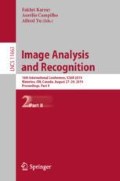Abstract
Under the impact of global climate changes and human activities, harmful algae blooms (HABs) have become a growing concern due to negative impacts on water related industries, such as tourism, fishing and safe water supply. Many jurisdictions have introduced specific water quality regulations to protect public health and safety. Therefore reliable and cost effective methods of quantifying the type and concentration of algae cells has become critical for ensuring successful water management. In this work we present an innovative system to automatically classify multiple types of algae by combining standard morphological features with their multi-wavelength signals. To accomplish this we use a custom-designed microscopy imaging system which is configured to image water samples at two fluorescent wavelengths and seven absorption wavelengths using discrete-wavelength high-powered light emitting diodes (LEDs). We investigate the effectiveness of automatic classification using a deep residual convolutional neural network and achieve a classification accuracy of 96% in an experiment conducted with six different algae types. This high level of accuracy was achieved using a deep residual convolutional neural network that learns the optimal combination of spectral and morphological features. These findings illustrate the possibility of leveraging a unique fingerprint of algae cell (i.e. spectral wavelengths and morphological features) to automatically distinguish different algae types. Our work herein demonstrates that, when coupled with multi-band fluorescence microscopy, machine learning algorithms can potentially be used as a robust and cost-effective tool for identifying and enumerating algae cells.
Access this chapter
Tax calculation will be finalised at checkout
Purchases are for personal use only
References
Toxic algae bloom in Lake Erie. NASA, October 2011. https://earthobservatory.nasa.gov/IOTD/view.php?id=76127
Barsanti, L., Gualtieri, P.: Algae: Anatomy, Biochemistry, and Biotechnology. CRC Press, Boca Raton (2014)
Canada, H.: Canadian Drinking Water Guidelines. Cyanobacterial Toxins - Microcystin-LR, July 2002
Coltelli, P., Barsanti, L., Evangelista, V., Frassanito, A.M., Gualtieri, P.: Water monitoring: automated and real time identification and classification of algae using digital microscopy. Environ. Sci. Process. Impacts 16(11), 2656–2665 (2014)
Deglint, J.L., Tang, L., Wang, Y., Jin, C., Wong, A.: SAMSON: spectral absorption-fluorescence microscopy system for ON-site-imaging of algae. J. Comput. Vis. Imaging Syst. (2018)
Falconer, I.R.: Potential impact on human health of toxic cyanobacteria. Phycologia 35(6S), 6–11 (1996)
He, K., Zhang, X., Ren, S., Sun, J.: Deep residual learning for image recognition. In: Proceedings of the IEEE Conference on Computer Vision and Pattern Recognition, pp. 770–778 (2016)
Minister of Health: Guidelines for Canadian Recreational Water Quality, 3rd edn. Health Canada, Ottawa (2012)
Huisman, J., Codd, G.A., Paerl, H.W., Ibelings, B.W., Verspagen, J.M., Visser, P.M.: Cyanobacterial blooms. Nat. Rev. Microbiol. 16(8), 471 (2018)
Michalak, A.M., et al.: Record-setting algal bloom in lake erie caused by agricultural and meteorological trends consistent with expected future conditions. Proc. Natl. Acad. Sci. 110(16), 6448–6452 (2013)
Murphy, D.B.: Fundamentals of Light Microscopy and Electronic Imaging. Wiley, New Jersey (2002)
Organization, W.H., et al.: Cyanobacterial Toxins: Microcystin-LR. Guidelines for Drinking Water Quality 2 (1998)
Otsu, N.: A threshold selection method from gray-level histograms. Automatica 11(285–296), 23–27 (1975)
Poryvkina, L., Babichenko, S., Leeben, A.: Analysis of phytoplankton pigments by excitation spectra of fluorescence. In: EARSeL-SIG-Workshop LIDAR. Institute of Ecology/LDI, Tallinn, Estonia, pp. 224–232 (2000)
Sayers, M.J., et al.: Satellite monitoring of harmful algal blooms in the western basin of Lake Erie: a 20-year time-series. J. Great Lakes Res. 45, 508–521 (2019)
Wynne, T., Stumpf, R.: Spatial and temporal patterns in the seasonal distribution of toxic cyanobacteria in western lake erie from 2002–2014. Toxins 7(5), 1649–1663 (2015)
Acknowledgements
The authors would like to thank the Canadian Phycological Culture Centre (CPCC) for preparing the algae samples, and Velocity Science for providing tools and resources for proper data collection. This research was funded by the Natural Sciences and Engineering Research Council of Canada (NSERC) and Canada Research Chairs program.
Author information
Authors and Affiliations
Corresponding author
Editor information
Editors and Affiliations
Rights and permissions
Copyright information
© 2019 Springer Nature Switzerland AG
About this paper
Cite this paper
Deglint, J.L., Jin, C., Wong, A. (2019). Investigating the Automatic Classification of Algae Using the Spectral and Morphological Characteristics via Deep Residual Learning. In: Karray, F., Campilho, A., Yu, A. (eds) Image Analysis and Recognition. ICIAR 2019. Lecture Notes in Computer Science(), vol 11663. Springer, Cham. https://doi.org/10.1007/978-3-030-27272-2_23
Download citation
DOI: https://doi.org/10.1007/978-3-030-27272-2_23
Published:
Publisher Name: Springer, Cham
Print ISBN: 978-3-030-27271-5
Online ISBN: 978-3-030-27272-2
eBook Packages: Computer ScienceComputer Science (R0)

